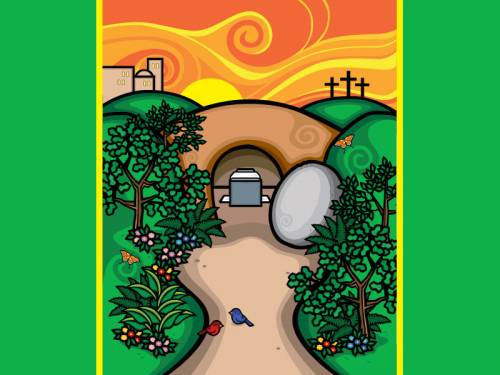New life awaits dying churches
July 2, 2019
 There are two constants in life: change and Jesus Christ, who is the same yesterday, today and tomorrow. In Christ, we live and move and have our being. To be a follower of his is to be forever mindful of the cross, of death’s defeat — and of resurrection power. And, as Wendell Berry wrote in one of his well-known poems, “Manifesto: The Mad Farmer Liberation Front,” we, the church, are to “practice resurrection.”
There are two constants in life: change and Jesus Christ, who is the same yesterday, today and tomorrow. In Christ, we live and move and have our being. To be a follower of his is to be forever mindful of the cross, of death’s defeat — and of resurrection power. And, as Wendell Berry wrote in one of his well-known poems, “Manifesto: The Mad Farmer Liberation Front,” we, the church, are to “practice resurrection.”
Having resurrection hope, though, is challenging, especially with the large number of mainstream churches closing every year. The statistics can be demoralizing. In the Presbyterian Church (U.S.A.) alone, membership in 2017 was 1,415,053, down from 1,482,767 in 2016.
Paul Grier, vice president of the Presbyterian Foundation’s Project Regeneration, says the reasons for the shrinkage have more to do with aging than with people leaving the faith. The median age in the United States is 37, but the average Presbyterian is 62. With an aging membership comes an empty-nest scenario. In other words, the trend is toward downsizing — and that includes church buildings that have become a financial burden to some congregations. In addition, according to a number of denominational and secular surveys, younger generations continue to reject organized religion due to scandals and corruption, along with what they perceive as judgmental and hypercritical churchgoers.
Yet no matter how troubling the “bad news” is, the good news is always greater. Regeneration and resurrection are already taking place; it’s a reality we are living in and living into. Grier says it is crucial to remember that practicing resurrection is about “remembering what the church is and what the church is not.”
“The church is the collection of believers. It is not the building where believers attend worship,” he said.
Project Regeneration empowers churches to “resurrect” by initiating a discernment process designed for congregations who are struggling to keep up with the maintenance of an older building and aren’t sure what to do. To arrive at resurrection, congregations must first undergo a period of mourning, a time of reflecting and resting before something new emerges, Grier says.
“A good reinvention takes at least three years, and averages five to seven years. It takes time, money and energy,” he added. Yet many congregations don’t have time, money or energy.
Research indicates that 80 members are needed for a church to be sustainable. The PC(USA) has 1,400 churches with 25 or fewer members, says Grier.
“With the responsibility of keeping a church viable on so few, many find they just don’t have the energy to do something new,” he said.
And while the maintenance of a building is a burden for many dwindling congregations, the building can be an asset.
“Different worshiping communities have risen from the ashes of the sale of a church building that was draining church finances,” Grier said. “After a church building is sold, many say they wished they had sold the property sooner.”
On Easter 2014, South Presbyterian Church in Rochester, New York, voted to sell their historic 170-year-old building as a symbol of resurrection. The church was sold to another denomination within a few months — a decision that they have never regretted, says the Rev. Deborah Fae Swift.
Today, the congregation still gathers but as an Acts of Faith community, modeled after the first-century church, going out into the world and bringing worship and fellowship to multiple venues. The Acts of Faith model emphasizes three areas: worshiping communities, studying and sharing, and social activities with a specific focus, most of which are member-led.
“We can just be about God’s work without spending time, energy and money on the building,” said Swift. “The model is simple: Go where we are needed and share the loving presence of the risen Christ.”
For example, people meet in restaurants for Bible study, worship at various venues, such as a senior retirement community, and host potluck dinners for refugee families.
Currently, the church holds five worship services throughout the week, including two that take place on Sunday morning. One-third to one-half of all those involved in Acts of Faith had no knowledge of South Presbyterian Church. Swift continues to serve as a full-time pastor, and the congregation has hired another full-time associate pastor, as it continues to use the proceeds of the building to support staff. Meetings and potluck dinners are held at a local park lodge. When the church building was sold, there were 33 members. Currently, there are 53 members, 12 affiliate members and 120 people who participate in the various activities offered.
“We are no longer a little church that’s dying,” Swift said. “We are no longer weeping over Jerusalem or mourning the loss of a building that was so confining. We are in awe of what God is doing here, and we give all the glory to God.”
Sherry Blackman, Pastor of Presbyterian Church of the Mountain, Delaware Water Gap, Pennsylvania
Today’s Focus: Resurrection Hope
Let us join in prayer for:
PC(USA) Agencies’ Staff
Rachel Anderson, PMA
Shelby Andrews, PMA
Let us pray:
Lord, help us to be the church you have called us to be. Show us how to share your love through service to others, and let that service be what draws others to you. In Jesus’ name we pray. Amen.